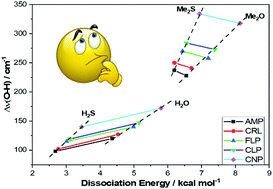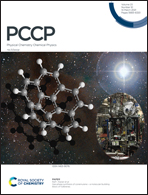O–H stretching frequency red shifts do not correlate with the dissociation energies in the dimethylether and dimethylsulfide complexes of phenol derivatives†
Abstract
In this perspective, we present a comprehensive report on the spectroscopic and computational investigations of the hydrogen bonded (H-bonded) complexes of Me2O and Me2S with seven para-substituted H-bond donor phenols. The salient finding was that although the dissociation energies, D0, of the Me2O complexes were consistently higher than those of the analogous Me2S complexes, the red-shifts in phenolic O–H frequencies, Δν(O–H), showed the exactly opposite trend. This is in contravention of the general perception that the red shift in the X–H stretching frequency in the X–H⋯Y hydrogen bonded complexes is a reliable indicator of H-bond strength (D0), a concept popularly known as the Badger–Bauer rule. This is also in contrast to the trend reported for the H-bonded complexes of H2S/H2O with several para substituted phenols of different pKa values wherein the oxygen centered hydrogen bonded (OCHB) complexes consistently showed higher Δν(O–H) and D0 compared to those of the analogous sulfur centered hydrogen bonded (SCHB) complexes. Our effort was to understand these intriguing observations based on the spectroscopic investigations of 1 : 1 complexes in combination with a variety of high level quantum chemical calculations. Ab initio calculations at the MP2 level and the DFT calculations using various dispersion corrected density functionals (including DFT-D3) were performed on counterpoise corrected surfaces to compute the dissociation energy, D0, of the H-bonded complexes. The importance of anharmonic frequency computations is underscored as they were able to correctly reproduce the observed trend in the relative OH frequency shifts unlike the harmonic frequency computations. We have attempted to find a unified correlation that would globally fit the observed red shifts in the O–H frequency with the H-bonding strength for the four bases, namely, H2S, H2O, Me2O, and Me2S, in this set of H-bond donors. It was found that the proton affinity normalized Δν(O–H) values scale very well with the H-bond strength.

- This article is part of the themed collection: PCCP Perspectives


 Please wait while we load your content...
Please wait while we load your content...